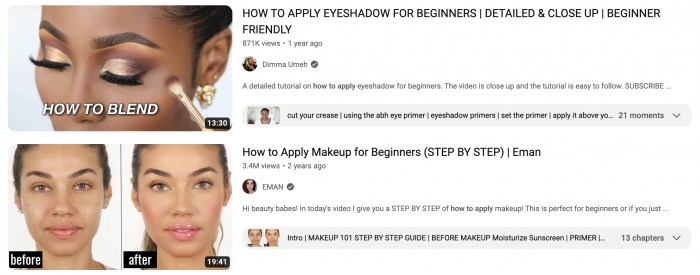The new marketing video is not remotely about you, your product, or your company. It’s about what you can teach your audience that will make them smarter, more efficient, or more effective at something they care about.
Here is a breakdown of why educational videos have become such a key part of successful content strategies, and inspirational examples of brands knocking it out of the park.
Why Educational Videos are So Successful
No one wants to be a know-it-all, right? Wrong.
We are living in the age of life-hacks, food-hacks, growth-hacks, and regular old hacks. If there is a smarter, better, faster way to do something, people will like it and share it and tell everyone they know.
The science behind this is relatively straightforward. We gain credibility amongst our peers when we have interesting and useful information to offer them. This reflects positively upon the person sharing the information in the eyes of their friend, while the person sharing feels good about themselves because they helped someone else.
Educational videos capitalize on this because they tap into our innate desire to better ourselves and help our friends do the same. With searches containing “how to” up 70% year on year, the demand for informative videos is clearly high and also growing.
How to Leverage Educational Content for Your Brand
The trick to creating compelling educational content is finding the right niche, and focusing on providing end-value for the viewer.
Business to Consumer
Home Depot has it relatively easy because DIY and home improvement are among the largest categories for “How To” videos in terms of viewer interest, and are a natural fit for their brand. Nearly everyone walking into their store is looking to learn how to use the new tools they bought, or properly apply indoor paint, for instance.
Even a relatively mundane video about how to clean a mattress managed to rack up more than 278,000 views:
Educational content has to be more useful than anything else, and that video about the more technical aspects of selecting a toilet is a perfect illustration of that point.
It’s not just about home improvement – it’s really about all types of self-improvement. Searching for “How to Apply,” for instance, turns up tons of results for different types of makeup products.
The demand for these videos is incredibly high. Videos about applying false eyelashes, notoriously tricky (as anyone who has ever tried will agree), get millions of views, and high levels of viewer engagement:

In case you’re starting to think it’s just homemakers or teenagers trying out different trends, more and more brands, such as MAC, Morningstar and Kleenex, are branching out even further into educational territory by turning to branded documentaries. Not only are these documentaries highly educational, they also get to showcase the more altruistic side of a company by focusing on topical social or environmental issues.
“How To” Content for B2B
That’s all well and good for consumer-focused brands, you might think. But what if I’m selling to other companies?
Educational content has been the bread and butter of B2B marketing for a long time. Conferences, webinars, white papers – all of those content types are dedicated to informing potential customers or engaging existing ones. The same is absolutely true for B2B video marketing.
IBM holds it down with online video for a B2B audience. Their IBM Technology channel frequently racks up thousands of views, and helps make a really complex and powerful piece of technology feel more personable and comprehensible.

Google Webmasters also does an excellent job of producing high quality content targeted at businesses. For instance, this video on “SEO for Startups in Under 10 Minutes” has racked up more than 500,000 views, and their channel has more than 200,000 subscribers.
How to Put Your Ideas into Action
When you think about your company or product, focus on the problems they solve for your customers, rather than their technical attributes, or differentiating features. Then, target your content according to different stages of the customer lifecycle, and adjust the topic and messaging accordingly.
For example, Home Depot doesn’t focus exclusively on the technical reasons why one type of paint might be better than another. They show techniques for applying paint, how to tape edges correctly, and tips for removing different types of paint from different surfaces.
People watching these videos might not have bought their paint at Home Depot, but they will certainly find their DIY videos useful, and might keep Home Depot top of mind the next time they are shopping. This is what is known as classic brand awareness, or top-of-funnel marketing.
When IBM puts out a video that shows what Watson can do with a Bob Dylan song, it might inspire people seeking a solution to an unusual problem to think of Watson rather than some other sort of hack.
How might you leverage educational content for your brand?








